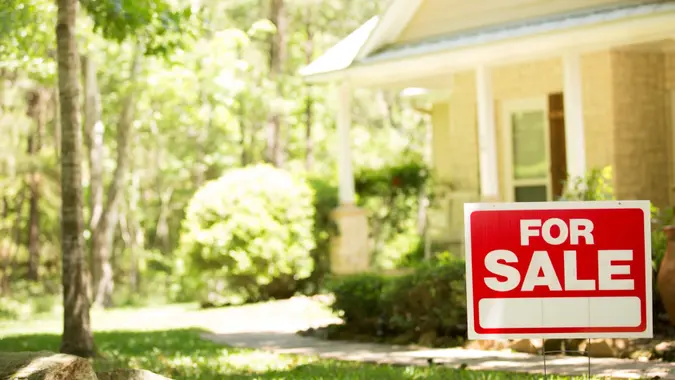I’m a Real Estate Agent: 5 Basement Details That Can Turn Homebuyers Away

Commitment to Our Readers
GOBankingRates' editorial team is committed to bringing you unbiased reviews and information. We use data-driven methodologies to evaluate financial products and services - our reviews and ratings are not influenced by advertisers. You can read more about our editorial guidelines and our products and services review methodology.

20 Years
Helping You Live Richer

Reviewed
by Experts

Trusted by
Millions of Readers
You’re ready to sell your home. The house is clean, clutter-free and perfectly staged — and you’ve got professional photos to prove it. Your listing has snappy copy that highlights how ideal your space has been for you — and how it’ll be just as perfect for another family. It’s go time.
While you may not have given as much TLC to your basement, you figure it can’t matter that much to prospective homebuyers.
Oh, but it can.
According to real estate agents and home experts, the condition of your basement can impact whether buyers want to strike a deal or walk away. As you prepare your home for the market, these experts recommended addressing several key issues below ground before planting that “For Sale” sign in the yard.
Foul Odors
Ray Franz, owner of CharterOak HomeBuyers in Connecticut, recalls walking into the basement of a home with buyers who were seriously interested — only for them to stop in their tracks when they caught a musty smell.
“Right there, their interest dropped in the home, and the seller ended up taking nearly 20% less than expected,” he said.
Factors that contribute to foul odors — like dampness, mold or cracks — need to be addressed as soon as possible. Nobody wants to invest in a space where they’ll feel like they need clothespins on their noses.
“On the other hand, I once had a client spend a few thousand sealing leaks and adding a sump pump, and it completely changed the story because the house sold quickly and at full price,” he added.
Antiquated Mechanical Systems
Jacob Naig, a real estate agent, investor and owner of We Buy Houses in Des Moines, has a similar story of a sale that fell apart after buyers discovered a troubling issue in the basement. In this case, it was an outdated and potentially costly foundation drainage and water management system.
“I remember walking a young couple through a property here in Des Moines where the basement had two sump pumps running constantly,” he said. “They ended up leaving before even seeing the upstairs, because, as they put it, ‘If the basement feels like a liability, the house isn’t worth the risk.'”
Naig calls outdated systems “a deal killer,” noting that corroded furnaces, old breaker panels or exposed wiring near moisture can shake buyers’ confidence in the entire property.
Lack of an Egress Window
An egress window is exactly what it sounds like — a window large enough to exit through in case of an emergency. It can be the key to turning a basement into a livable space — or even an extra bedroom that adds value.
Naig said that in Des Moines, like many markets, buyers want basement bedrooms that comply with local building codes — which means legal egress windows.
“One may cost $2,500 to $5,000 to install, but without one, that ‘bedroom’ won’t be counted in the appraisal,” he said. “I’ve seen sellers lose $20,000 in perceived value because their ‘four-bedroom’ house was really a three-bedroom with a nonconforming basement dweller.”
Moisture Issues
If there’s one issue Naig urges sellers to address before listing, it’s moisture in the basement. He added that while some homeowners try to hide water problems with a coat of paint, savvy buyers have a secret weapon: inspectors who can spot patch jobs.
Although waterproofing isn’t cheap, Naig said it’s often necessary to make a sale.
“A waterproofing system with a sump pump, drain tile and grading fixes can range from about $5,000 to $15,000, depending on severity, but it’s better to spend upfront than to repeatedly lose buyers,” he said.
Structural Problems
Naig also recalled a client with a beautiful 1920s home featuring excellent woodwork — but the basement told another story. Sagging support posts, efflorescence and persistent water after storms kept buyers away.
Only after his client invested $18,000 in repairs — including new support beams, drainage and cosmetic fixes — was the home able to sell.
“It sold, ironically, for $40,000 more than the asking price,” Naig said. “The basement was the silent wall all this time.”
 Written by
Written by  Edited by
Edited by 


























